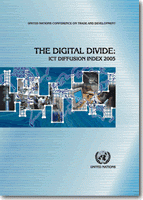
There is an immense information and communication technology (ICT) gap, a “digital divide”, between developed and developing countries. A person in a high-income country is over 22 times more likely to be an Internet user than someone in a low-income country. Secure Internet servers, a rough indicator of electronic commerce, are over 100 times more common in high-income than in low-income countries. In high-income countries, mobile phones are 29 times more prevalent and mainline penetration is 21 times that of low-incomecountries. Relative to income, the cost of Internet access in a low-income country is150 times the cost of a comparable service in a high-income country. There are similar divides within individual countries. ICT is often non-existent in poor and ruralareas of developing countries.
The report is outlined as follows:
- The first section presents the information and communication technology diffusion index (ICTDI) for 2004. There is a strong correlation between a country’s ICTDI and its income and level of human development as measured by the UNDP’sHuman Development Index (HDI). The top ranks are dominated by industrial countries from North America, Western Europe and the Asian Tigers, while many of the lower ranking countries are from Africa. Since the ICTDI is measuring the outcome of a complex socio-technical system, the ranks are relatively stable over time; however, more volatility is observed in low-ranking countries than in high-ranking countries.
- In section two, we see that regardless of the measure used, the digital divide exists and national rankings are quite consistent. In spite of the fact that there are many Internet cafés and other telecentres in low-income countries, a person in a high-income country is over 22 times more likely to be an Internet user than one in a low-income country; this is significant as 37 per cent of the world population lives in a low-income country.
- Section three presents case studies from China, Chile, Botswana, Singapore, India and the United States. These nations were selected because they have combined ICT liberalization — privatization, competition and independent regulation — withresponsible government planning, investment and procurement. We briefly outline thebroad political and economic context in which telecommunication policy is formed ineach nation, describe that policy and examine some of the results.
- Section four reviews the history and success of telecommunications and its privatization, competition and independent regulation (PCR), but also examines some of its limitations. This data, and the persistence of the digital divide, suggests that while historically beneficial, PCR may have reached a point of diminishing returns in many nations and that we now need to look beyond PCR. The section is concluded with considering proposals to construct public Internet backbones which would provide neutral connection points for competing service providers — the type of eclectic strategy we have seen in our case studies.
- The report concludes with appendices on the methodology used in computing the ICTDI and annexes showing the national ICTDI values for 2004 and the ranks for 1997-2004.


